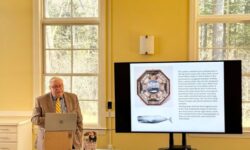By Amelia Tarallo
Hometown Weekly Staff
Every town comes with its own hidden treasure trove of gems. For some, it is the architecture. For others, it is the people who once called the town home.
In Walpole’s case, it’s both.
On Monday, April 22, Walpole Historian George Ransom gave a presentation on Plimptonville, a historic neighborhood in town. Today, hundreds of years later, many of the houses in Plimptonville are still occupied, some even by members of the Plimpton family. Ransom himself has been a resident of 31 Plimpton Street, one of the Plimptonville houses, for almost 40 years, making this presentation particularly meaningful for him.
Last September, residents of Walpole were invited to join Ransom on a walking tour of Plimptonville. Nearly 75 people attended the three-hour walking tour.
“Don’t worry, this isn’t going to be three hours long,” he joked at the beginning of his program. The presentation served both as a follow-up and as a virtual walking tour of the grounds. Each slide of the presentation provided a plethora of information, including facts addressing the people who lived in the houses, the unique characteristics of architecture, the differing building structures, and more.
One section of the presentation focused on the building of Plimptonville. Though what remains are some of the most stunning houses in Walpole, Plimptonville once included a number of shops and companies that made the area almost more like a tiny town in and of itself than a neighborhood of Walpole. Included was a trip hammer shop, a twine shop, a hosiery shop, a tobacco shop, a shop to sell cotton goods, and a carpentry shop. At the height of its productivity, there were more than 150 people working in the businesses of Plimptonville.
One of the most interesting structures located in the Plimptonville neighborhood is a castle. Built in 1879 by Isaac Newton Lewis, the castle has served as a reminder of how our Victorian predecessors loved being creative with their architecture. The castle was designed by J. Williams Beal, who also built Walpole’s town hall. Included in Ransom’s presentation were drawings of the castle, perhaps drawn by Lewis himself to show Beal exactly what he wanted the castle to look like.
Perhaps the most humorous of all of the stops listed in Ransom’s presentation was that of the Plimptonville Station. The railway stop, previously named Tiltons, was one of the few stops in town used by the Norfolk County Railroad. The stop is still used today as part of the MBTA’s Franklin line, but only an estimated 13 people use it each day. A train only stops there twice a day: once at approximately 6:58 a.m. and once at 5:50 p.m. Audience members laughed at the recollection of one previous resident’s stubborn efforts to ensure that the stop remained open, so that he could get into Boston during the week without having to travel through downtown Walpole. “He annoyed them enough that they kept it open. Amazing,” commented one audience member.
Walpole residents interested in visiting the area of Plimptonville need only to take a quick drive or walk to Plimpton Street, where they can see the beautiful historic houses and buildings that stretch through the area.
For those less inclined to travel, though, Ransom’s presentation served as a great reminder that history can be found in every corner of town, if you look hard enough.






















